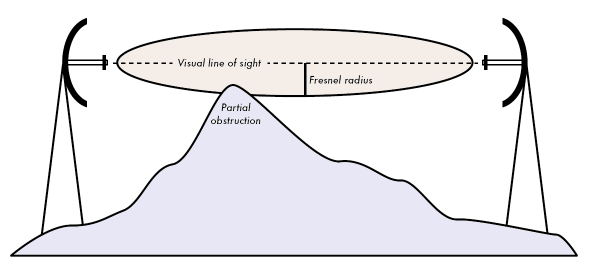| Wireles Networking is a practical guide to planning and building low-cost telecommunications infrastructure. See the editorial for more information.... |

|

Home  A Practical Introduction to Radio Physics A Practical Introduction to Radio Physics  Fresnel Zone Fresnel Zone |
|||
| See also: Line of Sight | |||






|
|||
|
Fresnel ZoneThe exact theory of Fresnel (pronounced “Fray-nell”) zones is quite complicated. However, the concept is quite easy to understand: we know from the Huygens principle that at each point of a wavefront new circular waves start, We know that microwave beams widen. We know that waves of one frequency can interfere with each other. Fresnel zone theory simply looks at a line from A to B, and then at the space around that line that contributes to what is arriving at point B. Some waves travel directly from A to B, while others travel on paths off axis. Consequently, their path is longer, introducing a phase shift between the direct and indirect beam. Whenever the phase shift is one full wavelength, you get constructive interference: the signals add up optimally. Taking this approach and calculating accordingly, you find there are ring zones around the direct line A to B which contribute to the signal arriving at point B.
Note that there are many possible Fresnel zones, but we are chiefly concerned with zone 1. If this area were blocked by an obstruction, e.g. a tree or a building, the signal arriving at the far end would be diminished. When building wireless links, we therefore need to be sure that these zones be kept free of obstructions. Of course, nothing is ever perfect, so usually in wireless networking we should check that that the area containing about 60 percent of the first Fresnel zone should be kept free. Here is one formula for calculating the first Fresnel zone: r = 17.31 * sqrt(N(d1*d2)/(f*d)) ...where r is the radius of the zone in meters, N is the zone to calculate, d1 and d2 are distances from obstacle to the link end points in meters, d is the total link distance in meters, and f is the frequency in MHz. Note that this gives you the radius of the zone. To calculate the height above ground, you need to subtract the result from a line drawn directly between the tops of the two towers. For example, let's calculate the size if the first Fresnel zone in the middle of a 2km link, transmitting at 2.437GHz (802.11b channel 6):
r = 17.31 sqrt(1 * (1000 * 1000) / (2437 * 2000)) Assuming both of our towers were ten meters tall, the first Fresnel zone would pass just 2.16 meters above ground level in the middle of the link. But how tall could a structure at that point be to clear 60% of the first zone?
r = 17.31 sqrt(0.6 *(1000 * 1000) / (2437 * 2000)) Subtracting the result from 10 meters, we can see that a structure 3.93 meters tall at the center of the link would block up to 60% of the first Fresnel zone. To improve the situation, we would need to position our antennas higher up, or change the direction of the link to avoid the obstacle.
|
|||
Home  A Practical Introduction to Radio Physics A Practical Introduction to Radio Physics  Fresnel Zone Fresnel Zone |
|||
Last Update: 2007-01-25


